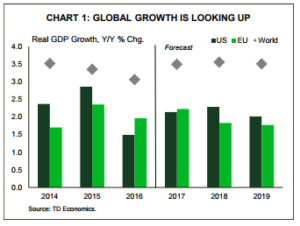FINANCIAL NEWS HIGHLIGHTS OF THE WEEK
- Finally, midway through 2017 global growth is looking better than it was a few months ago. Our latest Global Outlook discusses how the optimism that has been missing for several years has finally returned.
- With stronger global growth comes tighter monetary policy. This week the Fed formally took the next step of starting to reduce the size of its balance sheet.
- The Fed also reaffirmed that it expects to hike rates again this year. Our U.S. Outlook looks solid over the next two years, despite the hit from the devastating hurricanes. Reduced economic slack should lead to higher inflation, consistent with a gradual pace of rate hikes over the next two years.
We’ve Got To Admit Its Getting Better
In recent years, economic growth forecasts have suffered from serial disappointment. Economic outlooks have typically been downgraded part way through the year, but not so this time. Our latest Global Outlook discusses how a broadening and strengthening of expansions in advanced and emerging economies has helped restore a sense of optimism in the global economy that has been missing for several years.
 Global growth is on track to average 3.5% this year, and over the next two years. Highly accommodative monetary policy has done its job in sowing the seeds for selfsustaining economic growth across a number of regions. Now, with economic slack being absorbed at a faster clip, central banks are increasingly scaling back that stimulus. In the Euro Area, real GDP growth of 2.4% in the first half of the year was faster than expected, and nearly double the economy’s estimate of trend growth. As a result, the European Central Bank looks set to announce an end to its asset purchases at its upcoming meeting in October.
Global growth is on track to average 3.5% this year, and over the next two years. Highly accommodative monetary policy has done its job in sowing the seeds for selfsustaining economic growth across a number of regions. Now, with economic slack being absorbed at a faster clip, central banks are increasingly scaling back that stimulus. In the Euro Area, real GDP growth of 2.4% in the first half of the year was faster than expected, and nearly double the economy’s estimate of trend growth. As a result, the European Central Bank looks set to announce an end to its asset purchases at its upcoming meeting in October.
The Federal Reserve is further along in reducing monetary stimulus, with four rate hikes under its belt. This week it formally announced that it will start reducing the size of its $4.4 trillion balance sheet in October. The pace will be very gradual, with the monthly runoff amounting to 0.2% of its balance sheet. The process was already laid out clearly in June, and as such there was little reaction in the longer end of the curve.
Markets paid greater attention to the Fed’s message on future rate hikes, and how that may have changed given the softness in inflation this year. Yellen acknowledgedthat not all of the weakness in inflation can be chalked up to transitory factors (as we discussed in our latest forecast). However, interest rate projections for the nearterm were left unchanged. The median expectation of Fed members is for one more hike this year and three hikes in 2018. Confirmation that the Fed hasn’t lost its faith in the Phillips curve did produce an upward move in shorter-term yields. And, the odds on a rate hike in December have shifted from a coin flip to being roughly two-thirds priced in.
The Committee also indicated that recent hurricanes are likely to impact inflation and economic activity in the near term, disrupting it first and then boosting it thereafter as rebuilding begins. However, the storms are “unlikely to materially alter the course of the national economy over the medium term.” As such, we expect the Fed to see through any of the volatility in the data over the coming months, with the storms unlikely to prevent the Fed from potentially raising rates at their December meeting – particularly if inflation data firms as we expect.
Overall, the U.S. economy is expected to continue its “Steady-Eddie” performance of slightly better than 2% growth over the next few years. Upside and downside risks to this outlook remain: either from a fiscal boost from Washington or from delayed capital spending due to policy uncertainty on taxes or NAFTA renegotiation.
Leslie Preston, Senior Economist
This report is provided by TD Economics. It is for informational and educational purposes only as of the date of writing, and may not be appropriate for other purposes. The views and opinions expressed may change at any time based on market or other conditions and may not come to pass. This material is not intended to be relied upon as investment advice or recommendations, does not constitute a solicitation to buy or sell securities and should not be considered specific legal, investment or tax advice. The report does not provide material information about the business and affairs of TD Bank Group and the members of TD Economics are not spokespersons for TD Bank Group with respect to its business and affairs. The information contained in this report has been drawn from sources believed to be reliable, but is not guaranteed to be accurate or complete. This report contains economic analysis and views, including about future economic and financial markets performance. These are based on certain assumptions and other factors, and are subject to inherent risks and uncertainties. The actual outcome may be materially different. The Toronto-Dominion Bank and its affiliates and related entities that comprise the TD Bank Group are not liable for any errors or omissions in the information, analysis or views contained in this report, or for any loss or damage suffered.



